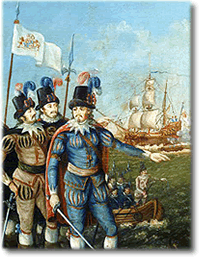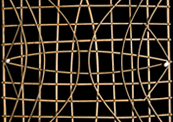
First Landing
Of Christopher Columbus
(Frederick Kemmelmeyer) |
Writing
a Book
Review.
Comprehensive,
Scholarly,
and Substantial.
This assignment has
two primary purposes:
1) to get everyone to read a comprehensive and reasonably scholarly biography of Christopher Columbus.
2) to give everyone an opportunity to write a book review, rather than a book report.
N O T E : The Columbus biographies listed at the end of this page are the suggested biographies for this assignment. If you find another biography of Columbus, you will need to get it approved by me before you can use it for this class. Juvenile level books and abridgements are not acceptable.
What is the purpose of book reviews? There are many different types of book reviews and they have somewhat different purposes. They appear in newspapers (Arkansas Democrat-Gazette), popular magazines (Newsweek), scholarly journals (Journal of American History, The Historian), and in specialized review publications (New York Review of Books, Choice, or History: Reviews of New Books).
All book reviews exist to tell the reader something substantial about the book and so spare the reader from having to read it themselves. As a result of reading the review, the reader may want to buy it and read it, check it out from the library and read it, buy it for a library so that the library patrons can read it, or ignore the book because its subject is of no interest or because it quality is poor.
The audience for book reviews will vary by publication. Newspapers and popular magazines publish book reviews to let their readers know about important or interesting new titles. They are aimed at a popular audience and review works of fiction and non-fiction that often are not at all scholarly in intent.
Some publications are a bit more highbrow than others. New Republic, New York Review of Books, TLS (Times Literary Supplement), and New York Times Book Reviews tend to publish more scholarly reviews as their readers are professionals and other intellectuals. Of course, it is important to keep in mind that reviews appearing in the New York Review of Books often spend more time talking about the book reviewer's ideas on the subject than the ideas presented in the book.
Other book reviews are written to tell librarians about new books. These reviews generally are very short (100-200 words), providing a brief description of the contents of the book and an evaluation.
Finally there are scholarly reviews of books. These appear in scholarly journals. Such reviews are 500-1500 words in length. They basically evaluate the books for other members of the profession. Book reviews written for this class will follow the pattern of a scholarly review.
A book review is not a summary of the contents of a book. Book reports summarize contents and they belong in high school. A good book review is a commentary on the book. That means that it analyses, evaluates, and judges the contents of the book.
10 Points for a Reviewer.
A reviewer must be thorough. Here are ten points to consider when you read a book for the purpose of reviewing it.
1) Find the author's point of view. This is often clearly stated in the introduction or preface.
2) Identify the author's major hypothesis, point, or contention. There may be more than one, or there may be a main point accompanied by several lesser but still important hypotheses. Again, most authors will state their point or hypothesis in the introduction and the conclusion of their book.
3) What types of evidence does the author use? Look at the footnotes, endnotes, and bibliography.
4) How is the book organized to present its argument? Is the organization effective?
5) How does the author use the evidence presented in the book? Is the evidence sufficient, is it convincing, is it appropriate?
6) Is the author's point of view appropriate? Is there a discernible bias, or is the author objective? Is the author true to that point of view in the way the book has been written? Always remember to respect how the author wrote the book, as long as it is appropriate. Do not criticize an author for writing a book (or an article) differently from how you would have written it. If you feel so strongly about it, write it yourself.
7) How does the book fit into the existing literature? Are there other books on this topic? Does the book revise them, enhance them, or contradict them? Is this book unique?
8) Based on the organization, argumentation, and evidence presented, do you find that the book contains a convincing argument?
9) If possible, compare the book with other books on similar topics.
10) Do you recommend this book to others? Why or why not? Comment on readability, whether the book grabbed your interest, was it useful, etc.?
The Structure of a Book Review.
I. Supply a brief summary or overview of the book's hypotheses and contents.
II. Assess the nature and the quality of the evidence presented.
III. Compare the work with similar titles.
IV. Comment on the author's presentation: organization, writing style, illustrations, tables, bibliography, index.
V. Conclusion with final assessment and recommendation to readers.
When reviewing a book, there are several other key words that can guide your efforts. Ask yourself, what is the author's purpose for writing this book? Purpose encompasses both point of view and hypothesis. Ask yourself, what is the scope of the book? Scope deals with what the book is about. What is its subject (person, time period, place, etc.?
It is also important to know something about the author. The keyword for this is authority. What is the author's authority? Does the author have expertise or a reputation in the subject? Beginning students will know little or nothing about the authors they are reading. That is why it is a good idea to look them up and learn about them. All the writers on your reading list are well known and significant historians who are the subjects of entries in biographical reference works.
Beginning students do not know where a book fits into to the historical literature. One way to quickly find out where it fits is to locate book reviews written by other scholars. How do they evaluate the book and why? Where do they say it fits? Their word is not necessarily gospel. Be sure you find good scholarly reviews, not simple library selection reviews, which are too short and lack detail for this purpose.
Remember, when writing your review, your audience is your classmates and your professors.
Your book review should be 3 to 5 pages long. Provide complete bibliographic information at the front, i.e., author's name, title, place of publication, publisher, year of publication, pages. Put your name at the end of the review. Look at various reviews published in scholarly journals and see how they do it.
The book review is due on 19 September 2007. It will be graded and returned to you.
Columbus Biographies
 Fernandez-Armesto, Felipe, Columbus
Fernandez-Armesto, Felipe, Columbus
 Granzoto, Gianni, Christopher Columbus
Granzoto, Gianni, Christopher Columbus
 Madariaga, Salvador de, Christopher Columbus
Madariaga, Salvador de, Christopher Columbus
 Morison, Samuel Eliot, Admiral of the Ocean Sea
Morison, Samuel Eliot, Admiral of the Ocean Sea
 Phillips, William D. and Carla Rahn Phillips, The Worlds of Christopher Columbus
Phillips, William D. and Carla Rahn Phillips, The Worlds of Christopher Columbus
 Sale, Kirkpatrick, The Conquest of Paradise
Sale, Kirkpatrick, The Conquest of Paradise
 Taviani, Paolo, Columbus
Taviani, Paolo, Columbus
 Wilford, John Noble, The Mysterious History of Columbus
Wilford, John Noble, The Mysterious History of Columbus
 Winsor, Justin, Christopher Columbus
Winsor, Justin, Christopher Columbus
|

